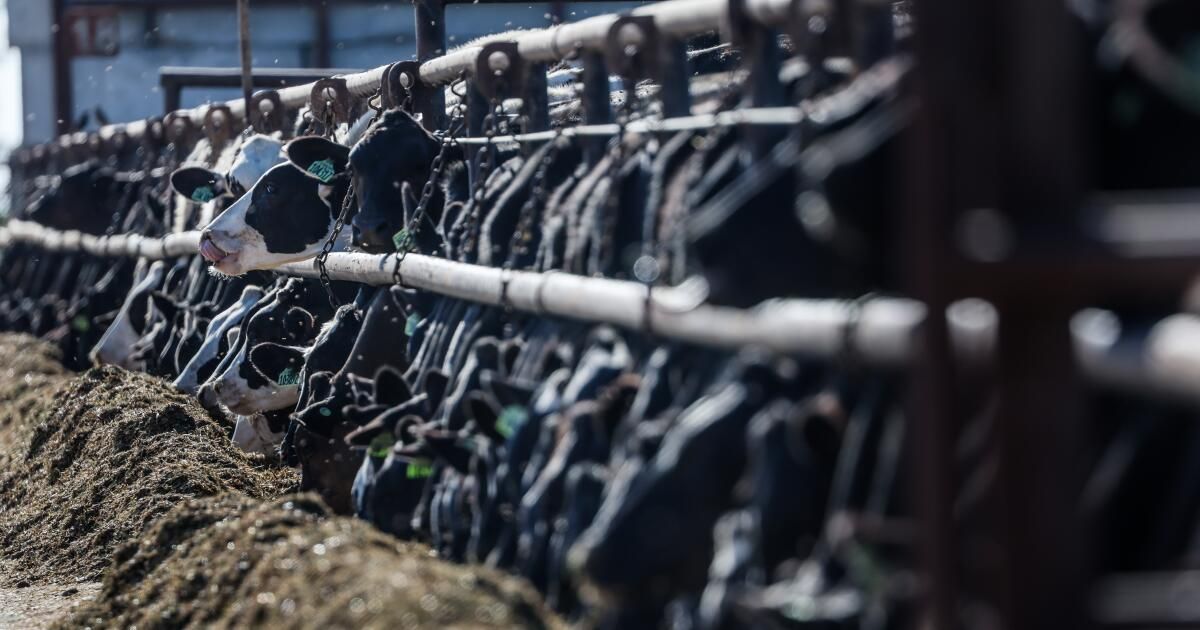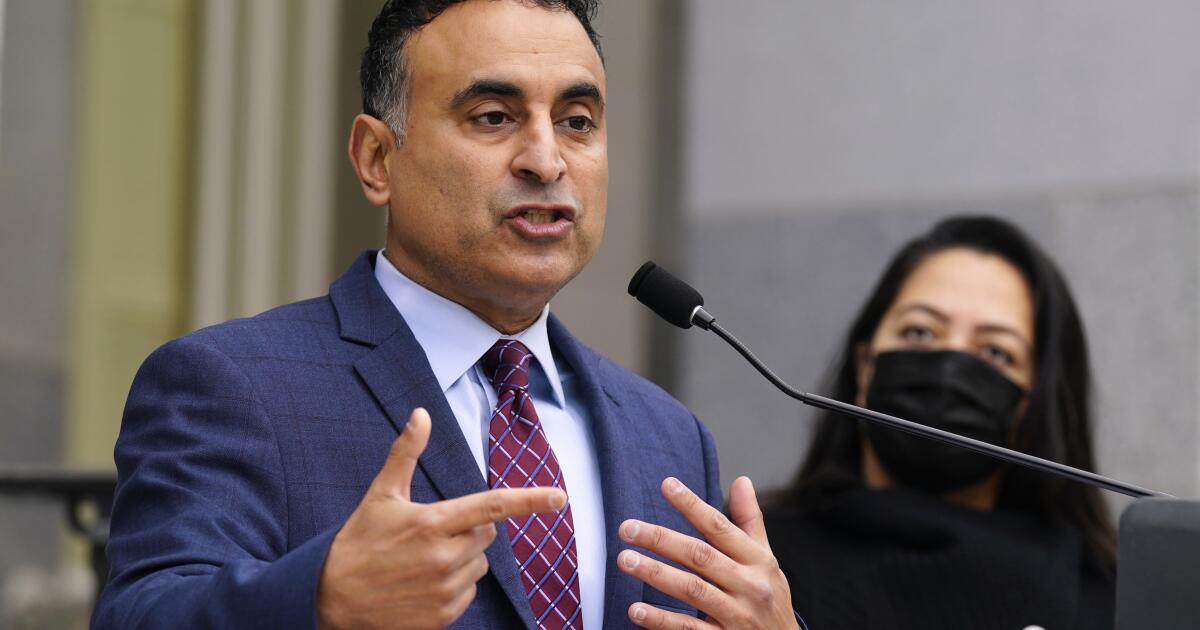The federal government has paid to the dairy farms of California more than $ 230 million to subsidize losses in milk production resulting from the aviar flu, according to the records, an amount that the dairy industry expects to increase as more claims are processed for damage.
The H5N1 Aviar flu has swept more than 75% of the 1,000 California dairy farms since August 2024, disgusting cattle and leading to a strong drop in milk production.
Farmers were able to obtain relief under a program of the United States Department of Agriculture known as Emergency Assistance for Cattle, Bees and the Fish Program raised in farms, or ELAP. The program generally provides assistance for farmers affected by forest fires, droughts and floods, but opened for dairy producers last year when the aviaré flu began to devastate their cows.
The records of the United States Department of Agriculture show that 644 payments were made to 359 Decifornia dairy farms between November 2024 and June 2025 for a total of $ 231 million. The average for payment of the farm was approximately $ 645,000, and varied from $ 2,058 to the Pereira dairy farm, in Visalia, at $ 4.4 million to Channel Islands Dairy Farm, in Corcoran.
However, these payments are expected to rise much more, as more claims are presented and process. Many of the payments issued in May and June were due to outbreaks in 2024, suggesting that there is more to come.
The relief payments were obtained through a request from the Farm Forward Freedom of Information Law, a non -profit group that advocates factory agriculture. The group affirms that subsidies help support dairy operations at an industrial scale that perpetuate the propagation of avian flu.
“These are mega industrial operations that are feeding an outbreak,” said Andrew Decoriolis, executive director of Farm Forward. “The avian flu extends exactly in the types of environments that we are paying to preserve.”
Anja Raudabaugh, executive director of the largest state commercial group in the industry, Western United Dairies, said the payments have “ensured that our dairy communities and their workers remain employed and healthy. Until we obtain the approval of a cow's dairy vaccine, this storm has only been possible with the assistance of milk loss payments.”
Jonathan Cockroft, managing partner of Channel Islands Dairy Farms, said that although payments helped with the fall of approximately 30% in the production of milk that his farm experienced, his losses exceed the $ 4 million he received.
He said the virus caused cows to abort their pregnancies, often prevented them from getting pregnant again. A dairy cow that does not give birth does not produce milk. In other cases, he said that the udders were so marked by the disease that cows could not produce milk at levels prior to infection.
“There is a completely different version, I am not sure that the public understands, which is the great impact on reproduction,” he said.
He also pointed out that many animals died, especially when the outbreak first hit the past fall, and his novelty was combined with the burning heat of the central valley demolished 10% to 15% of many California herds.
Joey Airoso, a dairy farmer in Tipton, received a subsidy of $ 1.45 million for an outbreak on his farm last October.
He said that the outbreak has cost him more than $ 2 million “only in milk revenue and that does not include the more than $ 250,000 additional attention costs” required to treat cows with medications, additional personnel and veterinary consultations.
And it does not cover the cost of the cows that died, that cannot produce milk or sell by meat. The average milk cow costs around $ 3,500, said Cockroft.
Jay van Rein, a spokesman for the Food and Agriculture Department of California, said that losses payments are “the most realistic way for producers to recover and avoid large interruptions in the food supply of these products.”
USDA officials did not immediately respond to a request for comments, but a former upper official of the USDA left in January said it was important state.
“This was a unique event in life, and we knew that we would need to support producers, and we knew that the faster we could get some help to help them try, the better we would be to be, and faster we could control the infection,” he said.
However, the decoriolis of Farm Forward and others say that these programs perpetuate an agricultural industry designed around hundreds, if not thousands, of genetically similar animals in confined lots: true children's parks for a new virus. He also noted that federal aid programs do not come with attached chains, such as incentives for disease mitigation and/or biosecurity.
Angela Rasmussen, a virologist of the organization of vaccines and infectious diseases of the University of Saskatchewan in Canada, said that delivering subsidies to the farms without trying to understand or investigate the practices they are using to cancel the disease is an error.
“What are they doing on farms to prevent reinfection?” She said.
The USDA payments were based on losses due to cow's milk production for a period of four weeks. According to Farm Forward's data, several farms received more than one subsidy. While approximately half received only one payment, 100 farms received two payments, 58 received three, 19 received four and two received six separate payments.
In a farm in Tulare County, four USDA payments were presented once a month between November 2024 and February 2025. In another, payments extended from December 2024 to May 2025.
Rasmussen said that multiple payments are probably based on specific circumstances in the milk involved.
Cockroft of the Dairy of the Canal Islands said that he and other farmers have seen resting waves and milk tests that remain positive for months. He said he knew of a farm that was quarantine for nine months.
When herds are quarantine, animals are not allowed to be transferred inside or outside. In California, a farm is under quarantine for 60 days after the initial detection of the virus. You cannot move from quarantine until the tests show that your milk has no virus, for three weeks in a row.
Van Rein, the state agriculture spokesman said that the average time under quarantine is 103 days. He said that of the 1,000 herds in California, 940 are not under quarantine; 715 of them had been previously infected and released from quarantine.
However, a quarantine farm can still sell milk, even if milk positively. It has been shown that pasteurization kills the virus.
Relief payments are another sign of how the United States government supports the agricultural industry, which some consider vital for national interest.
“We have politically decided that this is an industry that we want to support, which was affected by something that obviously was not their fault, and that we are going to help them, because it was a disastrous that hit the industry,” said Daniel Sumner, an agricultural economist of UC Davis. “If we think of these payments, since we are using our tax money to help someone who needs it, because your family is poor, that is not the case.”












